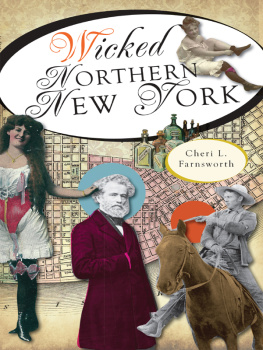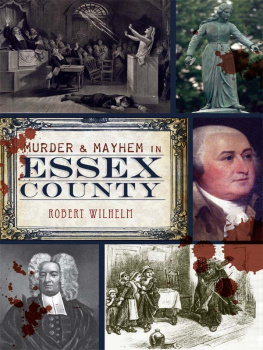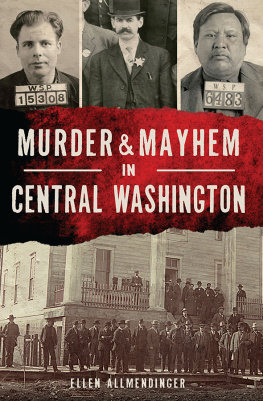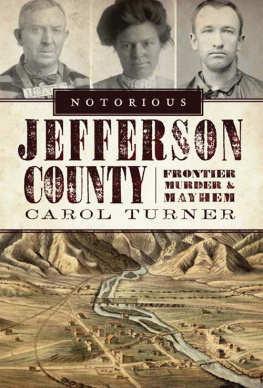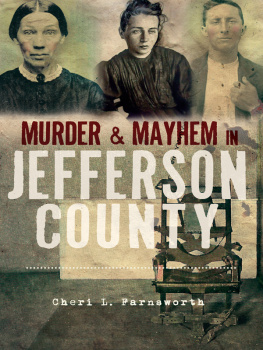

Published by The History Press
Charleston, SC 29403
www.historypress.net
Copyright 2010 by Cheri L. Farnsworth
All rights reserved
Cover images from the Collections of the St. Lawrence County Historical Association and the authors personal collection.
First published 2010
e-book edition 2012
ISBN 978.1.61423.316.9
Library of Congress Cataloging-in-Publication Data
Farnsworth, Cheri, 1963-
Murder and mayhem in St. Lawrence County / Cheri Farnsworth.
p. cm.
Includes bibliographical references.
print edition ISBN 978-1-59629-964-1
1. Murder--New York (State)--Saint Lawrence County--History--Case studies. 2. Murderers--New York (State)--Saint Lawrence County--History--Case studies. 3. Saint Lawrence County (N.Y.)--History. I. Title.
HV6533.N5F37 2010
364.1523092274756--dc22
2010022413
Notice: The information in this book is true and complete to the best of our knowledge. It is offered without guarantee on the part of the author or The History Press. The author and The History Press disclaim all liability in connection with the use of this book.
All rights reserved. No part of this book may be reproduced or transmitted in any form whatsoever without prior written permission from the publisher except in the case of brief quotations embodied in critical articles and reviews.
This book is dedicated to:
Marcia Scarborough
Adaline Scarborough
Marian Scarborough
Jean Macue
Sarah Jane Gould
Almon Farnsworth
Maria Shay
Mary Bartholomew
Kate Conroy
Joseph Kipp
Sumner Hazen
Jerry Apple
Elmer Crowder
Harry Hosmer
Henry LaDue
James LaDue
Harriet LaDue
Josephine Rogers
Dr. Theron Jenkins
Bessie White
CONTENTS
PREFACE
While every effort was made to obtain original photographs or sketches of each individual described in this bookmuseums, historians, newspapers and even prisons were all contactedmost of the images used in news articles written up to 200 years ago have long since been destroyed or lost. Neither the newspaper offices nor the various historians I contacted had any of the original images I sought of the criminals and their victims. Most of the countys voluminous newspaper archives have now been stored on microfilm or digitized and then discarded in an effort to free up space in facilities that once housed the brittle paper relics. And pages with photographs pertinent to this book were not scanned at nearly a high-enough resolution at that time to be of use to us for commercial print. So, in a few cases, I improvised. From my personal collection, I carefully chose original antique photographs of unknown individuals who closely resembled victims described herein, based on faded newspaper images and descriptive newspaper accounts. When such a photograph is used, the end of the caption will say: Courtesy of the author.
ACKNOWLEDGEMENTS
Id like to thank my commissioning editor at The History Press, Whitney Tarella, and my project editor, Amber Allen, for their enthusiasm and expertise; also, the New England sales rep, Dani McGrath; Jamie-Brooke Barreto of sales and marketing; and my publicist, Katie Parry, and assistant publicist Dan Watson. Theyve all been an absolute pleasure to work with.
Many thanks to St. Lawrence County historian and executive director of the St. Lawrence County Historical Association, Trent Trulock; deputy St. Lawrence County historian and collections manager for the historical association, Sue Longshore; and JeanMarie Martello and others who staff the research room for their incredible patience and expertise in assisting with the extensive search for images found in this book. The historical association, located in the Silas Wright House on Main Street in Canton, is a vast wonderland for history researchers and enthusiasts. Trustee Stan Maine was kind enough to provide me with portions of his great-great-grandfathers diary, which proved useful to my story about Almon Farnsworth. The efforts of Mitch Bresett, special collections and archive assistant for the Owen D. Young Library at St. Lawrence University, were much appreciated, as well. Im also grateful for the efforts of Jean Grimm, Town of Fine historian; Joe Lorenzo, Gouverneur Village historian and curator of the Gouverneur Museum; and Carl Stickney, Stockholm town historian and president of the board of trustees of the St Lawrence County Historical Association, who kindly met with me and offered his assistance.
The most gratitude goes to my husband, Leland Farnsworth II, for his unwavering encouragement and support of each book I write and to my daughtersMichelle, Jamie, Katie and Nicolewho keep me in the present and remind me of the inherently good side of human nature today, when too often Im caught up in writing about the depraved deeds of our ancestors. I can never thank my parents, Tom and Jean Dishaw, enough for their continuous love and support; or my siblings, Tom Dishaw, Christina Walker and Cindy Barry. Other people who warrant special mention include my in-laws, Lee and Carol Farnsworth, and my sisters families: Ed, Rachel, and Ryan Barry; Danon Hargadin; and Heather, Amanda, Bryan, Lindsey and Cade Alexander Walker.
INTRODUCTION
In 1816, when the first murder in this book occurred, St. Lawrence County was but an infant from a history standpointhaving been officially designated as its own distinct region just fourteen years earlier. In terms of land mass, this is hands down the Empire States largest county, with 2,701 square miles. As such, there was much hostile ground to cover between the villages and hamlets that sprang up across the landscape throughout the 1800s and early 1900s. There were harsh winter-weather conditions to contend with; the few roads that existed were often impassable, due to snow cover and flooding; packs of roving wolves and panthers became such a threat to farms and homesteads that in 1871 a bounty was placed on the species to eradicate them from the region; and lawless marauders and transient vagabonds were as much a threat to the north country as anywhere, I suppose. Perhaps the most dangerous factor of all, however, in our countys early history, was not what its hardy and determined people endured out there, but, rather, the threats they often faced within the confines of their very own homes. Of the twelve sensational crimes I chose to include in this volume, more than half had elements of familial tiescrimes of passion, if you will. Others involved neighbors and trusted acquaintances. One was clearly a case of wrong place, wrong time. And two were never solved.
Wife and fiance murders were surprisingly common in the nineteenth century, and the significant others who did the deeds were surprisingly inventivenot to mention cunning and coldheartedin their modus operandi. In 1857, James Eldredge, for example, slowly and deliberately poisoned his pregnant fiance, Sarah Jane Gould of Louisville, under the guise of lovingly administering the medication the doctor prescribed to cure hermedicine that was later found to be tainted with arsenic. Van Van Dyke was still a teen when he was coerced into marrying young Mary Bartholomew, who was pregnant by another man. He shot and killed her a week after their wedding and claimed it was accidental; that he had been set up and his gun loaded without his knowledge. Frank Conroy sliced and diced his beautiful wife in Ogdensburg in 1897 after telling the constable to close the door and walk away. And the constable




